New Openings
The Ultimate Guide to Restaurant Name Ideas
July 13, 2022
What’s in a name? A lot of brainstorming, sweat and tears. Learn how to create a great restaurant name.
If you’re thinking about opening a restaurant, congrats! One of the most fun albeit challenging creative decisions that you’ll need to make is choosing a restaurant name. You want it to be distinctive yet pronounceable and memorable yet uncommon. Most importantly, the name should have substance with (ideally) a neat backstory behind it.
A recent piece in Bon Appétit notes that “every third restaurant you pass has practically the same name.” So how do you stand out? Keep reading for an exploration into noteworthy names, why they work and actionable tips for locking down your decision before someone else scoops it up.

RESOURCE
How to Open a Restaurant [Free Guide]
A step-by-step guide to planning, financing, staffing, stocking and marketing a new restaurant for its debut.
What Makes a Great Restaurant Name?
The challenge of picking the perfect name for your restaurant is nothing new. Industry publications have been writing about the difficulty for years.
In 2014, Berkley, CA, branding agency A Hundred Monkeys shared a deep dive on the restaurant naming trend of “Blank and Blank” (names like Squat & Gobble and Goose & Gander). And in 2017, Food & Wine published a piece about the rise of super-long, sentence-length restaurant names. The author argues that lengthiness may make for better memorability — citing examples like Carthage Must Be Destroyed, Leave Rochelle Out Of It and Mongoose Versus Cobra — but notes that there’s a delicate line between enthralling and excessive.
If you’re feeling overwhelmed and at a loss for where to begin, that’s perfectly natural. But there’s no need to use an impersonal tool like a restaurant name generator. We’ve combed through hundreds of Yelp pages, Google searches, TripAdvisor round-ups and city guide listicles for examples of awesome restaurant names to inform your own selection. Here are nine tips to steer you in the right direction.
1. Invoke Curiosity
Curiosity might have killed the cat, but it’ll drive diners through your doors. A name that builds intrigue and sparks conversation can put (and keep) your restaurant on diners’ radar. More than that, it can give new customers the push they need to see what your restaurant is all about.Example: Disco Cheetah
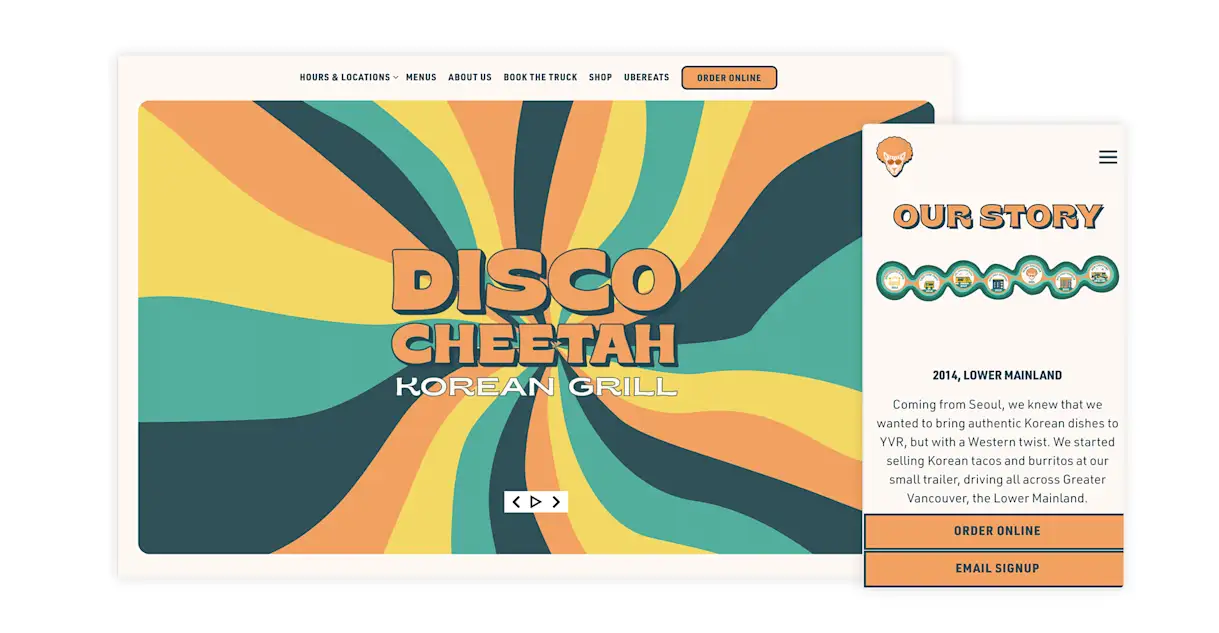
Disco Cheetah is a food truck and brick-and-mortar spot whipping up fast-casual Korean cuisine like rice bowls with fried tofu & gochujang tomato sauce, bulgogi beef and Napa cabbage kimchi. Its name is integrated into everything from its logo (a cheetah rocking shades and big hair) to its tagline (Serving Real Food, Fast!). Its dishes are bold and fresh, and that’s reflected in its branding too.
Other Examples:
The Peached Tortilla: An Austin food truck turned brick-and-mortar named after the feeling of being captivated by taste (“to get peached is to be completely flavor smitten”), with a nod to the well-known taco trio on its menu.
Bathtub Gin: A New York City speakeasy named for the homemade alcohol that was watered down in bathtubs during the years of Prohibition.
Seven Lamps: An Atlanta eatery named after an essay, The Seven Lamps of Architecture, by 19th century writer John Ruskin. The piece of writing describes his principles or “lamps” of architecture: sacrifice, truth, power, beauty, life, memory and obedience.
2. Make it Memorable
Consider that 45% of people find a new restaurant from word-of-mouth, mostly from friends and family. People often share recommendations verbally, in conversation — which means when someone goes to Google your restaurant later, the name must be unique enough to stick in their mind.
Example: Merry Piglets

Part of the ethos for Merry Piglets is “to create a fun, lively, relaxed environment where you can unwind and feel like part of the family.” Both words (merry and piglets) evoke playful imagery, following through on the restaurant’s commitment to the words “fun” and “lively.” The name is definitely easy to remember and gets bonus points for being entertaining to say!
Other Examples:
Fat Baby: A South Boston sushi spot named after the tongue-in-cheek placeholder the restaurant group's founding team used to describe their widest and smallest restaurant.
Dirty Rascal: An Atlanta newcomer serving classic Italian-American cuisine, named after James Beard-nominated Chef Todd Ginsberg’s childhood nickname.
Spice Finch: A Philadelphia Mediterranean bar and restaurant named after the Finch bird that eats primarily seeds (aka “all the spices that flavor our restaurant,” according to owner and Top Chef alum Jennifer Carroll).
3. Describe Your Menu
Your cuisine can be your first stop for name inspiration. Naming your restaurant in a way that showcases your ingredients or menu offerings lets diners know what to expect. This approach might sound more practical than creative, but the examples below show how to do it artfully.
Example: Citrus & Salt
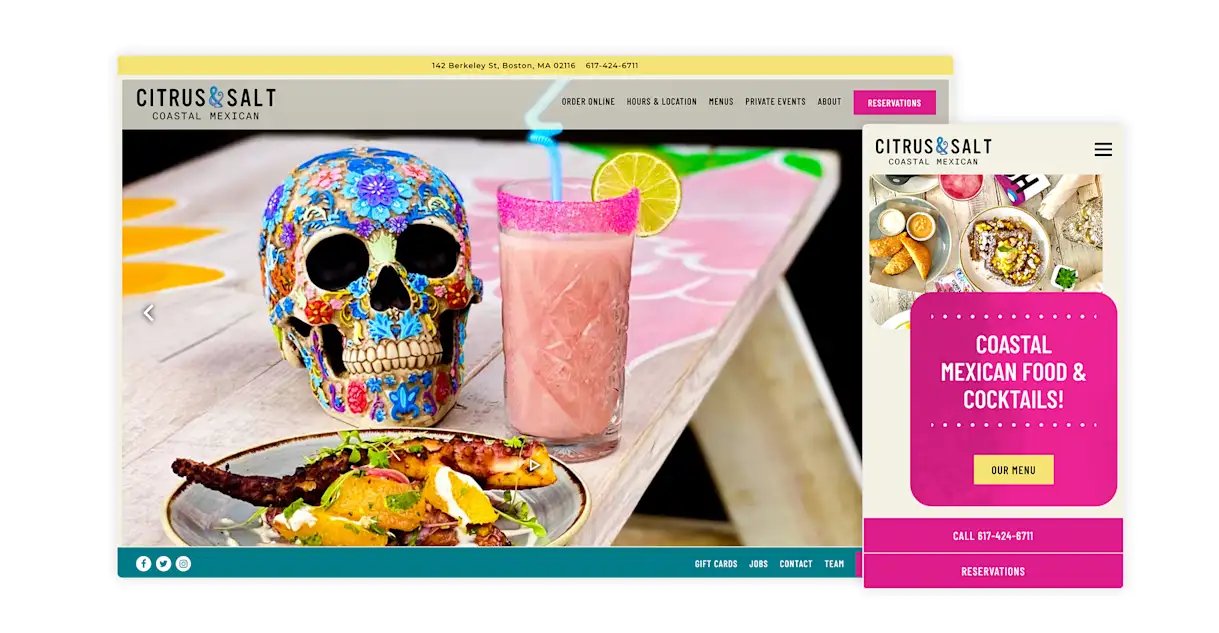
Citrus & Salt, a Boston-based Coastal Mexican joint, uses its name to emphasize the key components of margaritas: lime juice and a salt rim. Citrus also shows up elsewhere on the menu in lime cabbage slaw, lemon crema and a citrus vinaigrette on its grapefruit, avocado and butter lettuce salad.
Other Examples:
Mermaids & Cowboys: A La Jolla, CA, seafood spot and steakhouse cleverly named after those two menu components. “Mermaids” represents the range of underwater catches on the menu (oysters, clams, tuna, shrimp, lobster) and “Cowboys” is a callout to the beef-heavy dishes that round out the offerings.
Heads & Tails: A Houston cajun restaurant named after the different parts of shrimp, crab and crawfish you’ll find in its seafood boils.
Saltie Girl: A Boston-based seafood bar named after owner Kathy Sidell’s passion for eating her way through the saltiness of the sea’s bounty. It’s also a shoutout to the restaurant’s curation of one of New England’s largest tinned seafood collections.
4. Connect to Your Concept
Can you describe your concept without using the exact words of what you offer? For example, think about the name of a Latin American-inspired restaurant that doesn’t use the words taqueria, cantina or taco. The result, like The Painted Burro, would be a unique name that differentiates you in the dining scene. This is one of the best but hardest ways to name your restaurant. When it’s done right, the result is a spot-on moniker that just clicks with diners.
Example: Sunday’s Best

Sunday’s Best in Sandy, UT, has taken a beloved weekend tradition and extended it to an all-day brunch menu served seven days a week. The name is a spin on the phrase “Sunday best,” which typically describes the fine clothing people wear to church. It also acknowledges the connotation of brunch as a popular Sunday tradition.
Other Examples:
Spread & Co.: An Austin grazing board company turned cheese-centric cafe, named after its delicious spreads of charcuterie boards.
Back Door Donuts: A Martha’s Vineyard bakery named after the back door where they dole out donuts after dark (7pm to midnight).
Broken Shaker: An innovative cocktail concept with bars in New York, Los Angeles, Miami and Chicago, named after a mixologist tool that’s used so many times, it busts.
5. Showcase One Word
Sometimes less is more — and occasionally, one word is all you need to communicate the essence of your restaurant. The trick with a one-word restaurant name is that it needs to be powerful and punchy to really work. Strive for unconventional and uncommon.
Example: Krill
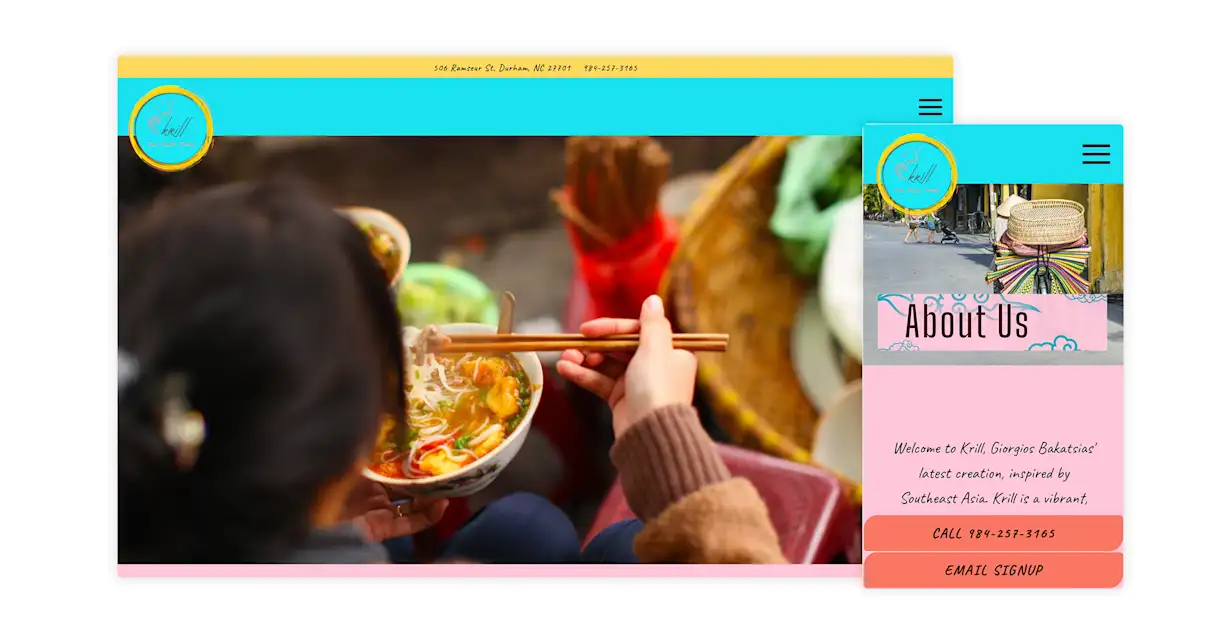
Giorgios Bakatsias is crushing Far East Funk cuisine at Krill in Durham, NC. Named after a tiny crustacean that’s most widely consumed in Southeast Asia, the restaurant incorporates the creature into its logo and menu with krill sambal and krill fried rice. Krill is a quirky choice that stands out among the run-of-the-mill names.Other Examples:
Suerte: An East Austin hideaway serving traditional Mexican fare with local Texas ingredients, named after the Spanish word for “luck.”
Hot Box: A Somerville, MA, staple dishing out North Shore roast beef sandwiches and South Shore bar pizza, named after the slang term (if you know, you know) while alluding to the literal hot box of a freshly baked ‘za.
Sift: A Mystic, CT, bake shop named after the step that declumps flour before baking.
6. Use Alliteration
The repetition of a letter at the beginning of back-to-back words is more than a literary device — it’s an easy way to stand out in the sea of restaurant names. This technique creates rhythm and a sort of “bounciness” that’s pleasing to the ear. Alliteration also helps people remember, so it’s another tactic to create memorability.
Example: Burro Bar
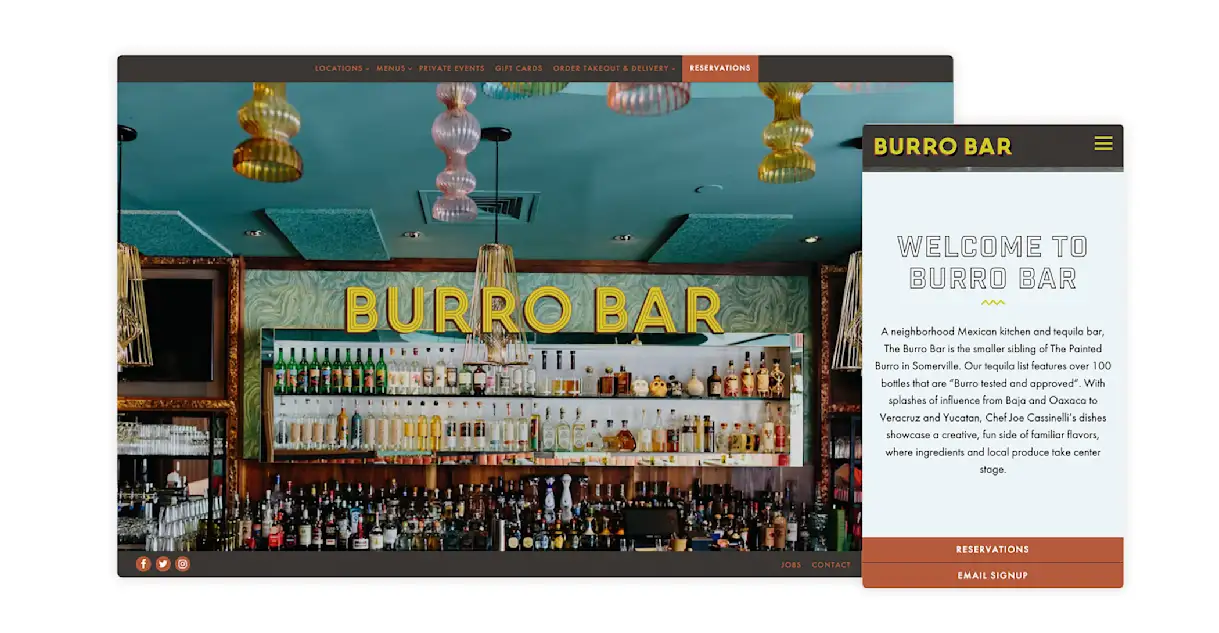
Burro is the Spanish word for donkey, and right off the bat, diners know what to expect at Boston’s Burro Bar. The Mexican kitchen and tequila bar is actually an offshoot of its big sister restaurant, The Painted Burro. In this particular usage of alliteration, Burro Bar rolls right off the tongue.
Other Examples:
Lost Larson: A Chicago bakery-café named after owner Bobby Schaffer's forgotten family surname. Schaffer’s paternal grandfather ditched his Danish last name, Larsen, in favor of his boss's name, Schaffer, sometime in his 20s. The restaurant name is also in memory of Schaffer’s maternal great grandfather named Lars Larson
Radio Room: A 10,000-square-foot song lovers paradise in Chicago, named to acknowledge the live music performances and DJ sets it hosts.
Salty Sow: An Austin gastropub named for the pork-heavy dishes that fill the chef-driven menu — and a celebration of the first part of its tagline (swine + wine + beer).
7. Pay Special Tribute
Not sure which direction to go when selecting a name? Consider using the opportunity to spotlight someone special in your life — especially if they connect with your restaurant’s cooking. Whether it’s a dog, daughter, wife or grandfather, you can show your appreciation with this gesture.
Example: Lily P’s
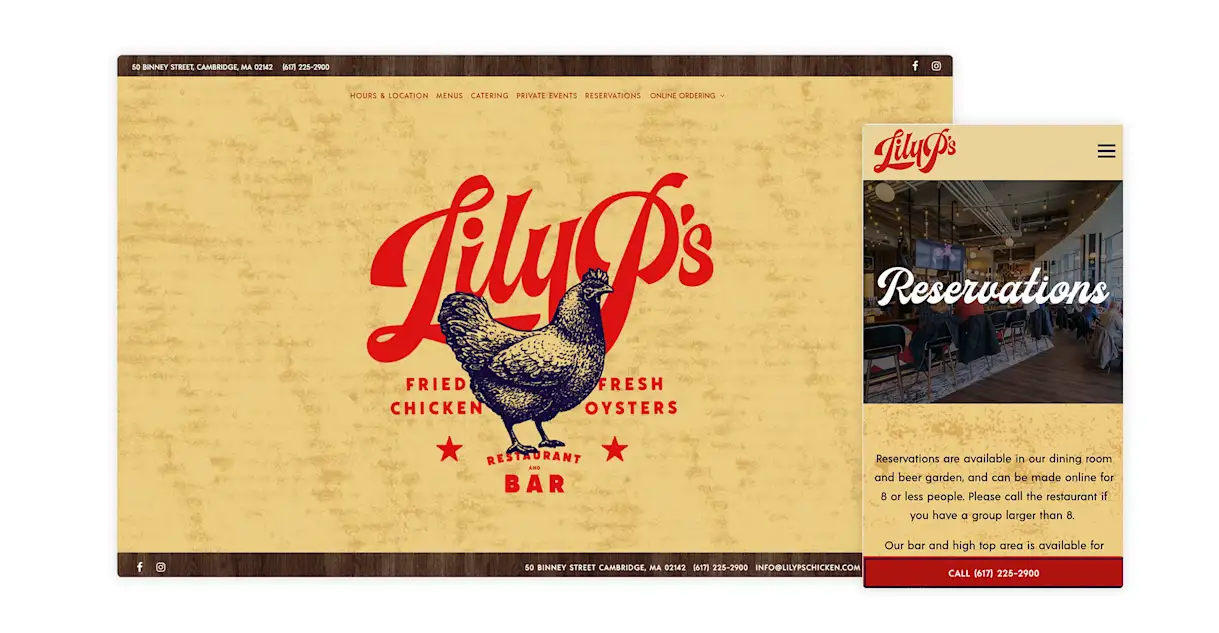
Chef Chris Parsons is no stranger to naming concepts. For his third time around, he decided to name his fried chicken establishment after his daughter. The food at Lily P’s reminds Parsons of family memories — and what better way to honor that nostalgia than naming the place after one of his kids.
Other Examples:
Mr. Digby’s: A San Francisco gathering place named after the owner’s childhood pet, an Old English Sheepdog. The social pup was well-known in the family’s neighborhood. The restaurant name is a salute to his vivacious spirit and represents the spot’s desire to be “a neighborhood staple where we know each other by name.”
Young Joni: A Northeast Minneapolis pizzeria, named as a tribute to the mothers of chef-owner Ann Kim and her husband/business partner Conrad Leifur. Kim's mother is named Young while Leifur's mother is named Joni.
Gertie: A modern Jewish diner and bar in Brooklyn named after founder Nate Adler’s maternal grandmother.
8. Allude to the Owner/Operator
The simplest way to connect a proprietor to their concept is to name the restaurant after them (for example, “Luke’s Diner.”) But there's a subtle, more artful way to do this: nod to the owner instead of naming them outright. When done correctly, this doesn't just honor the head honcho; it invokes the curiosity discussed earlier in this list.
Example: The Tailor’s Son
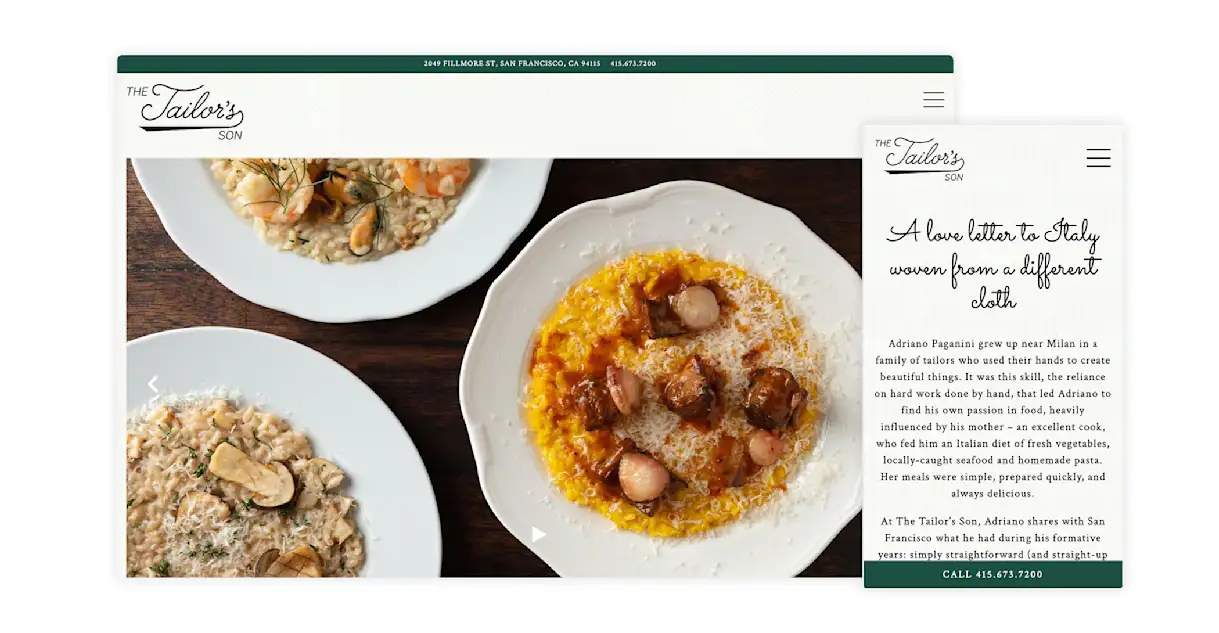
Adriano Paganini’s Northern Italian restaurant, The Tailor’s Son, describes itself as “a love letter to Italy woven from a different cloth.” The restaurant’s name is a discreet description of who Paganini is — quite literally a tailor’s son. He grew up near Milan surrounded by a family who used their hands to alter garments, making way for him to use his own hands to cook instead.
Other Examples:
Girl & the Goat: A Chicago and Los Angeles small plates spot named after chef-owner Stephanie Izard. Izard is the name of a goat-antelope found in the Pyrenees Mountains. Goat makes its way onto the menu as well, bringing everything full circle, with dishes like goat yogurt, goat liver mousse, confit goat belly and goat empanadas.
The Farmer’s Daughter: A farm-to-table brunch and lunch joint with two locations in the Boston suburbs, named after head chef and owner Chandra Gouldrup, an actual farmer’s daughter. Her father grew up as a potato farmer in Maine and, along with her culinary-inclined mother, inspired her to go from the family kitchen to a professional one.
Fox & the Knife: An Italian-inspired neighborhood restaurant nestled in South Boston that’s run by chef Karen Akunowicz. The name was a suggestion from Akunowicz’s partner, who called her the “the fox with the knife.”
9. Play With Words
Fun rhymes, odes to pop culture and puns all have their place in the restaurant name game. However, it’s easy for restaurants to get carried away with this. Your audience may like “punny” jokes, but if they don’t — and many people don’t — make sure any word play is clever, not tacky.
Example: Angry Egrette Dinette
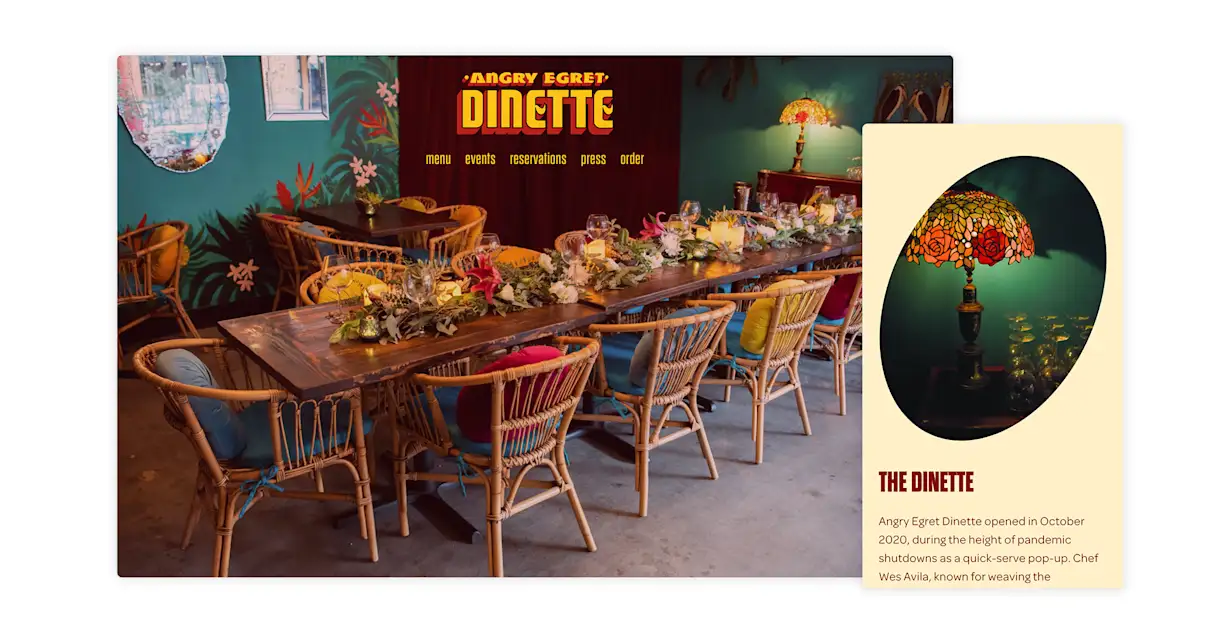
Wes Aliva came up with the lyrical name Angry Egret Dinette after watching two egrets fight over a piece of fish. What began as an inside joke between him and his wife became the roots for this spot, which opened during the pandemic and was named a 2022 James Beard semifinalist for Best New Restaurant. The name is fresh, fun and rolls right off the tongue in a sing-songy sort of way.
Other Examples:
James & the Giant Cupcake: An Oakland, CA, cupcakery named as a twist on popular Roald Dahl children’s book (and movie), James and the Giant Peach.
Phuc Yea: A downtown Miami concept cooking up Viet-Cajun cuisine with a tongue-in-cheek name that also gives an applause to its roots. “Phuc,”after all, means “blessings and prosperity” in Vietnamese.
Justice of the Pies: A Chicago-based bakery popping up at markets around the city is a play on the title “justice of the peace,” a judicial officer that handles things like hearing misdemeanors and traffic offenses — along with officiating weddings.

BentoBox Marketing & Commerce Platform
Opening a New Restaurant?
Help customers find you. 80% of diners search online before visiting a restaurant.
Ideas to Brainstorm Restaurant Names
It’s one thing to look at a list of already established spots. It’s another to think through the naming of your own place. Use the prompts below to get yourself thinking about what might work for an upcoming concept. Grab a pen and paper or take notes on your computer, and get the juices flowing.
Celebrate your street name or cross streets. If it works, it works — but don’t force it. Some restaurateurs are lucky to be blessed with a great sounding road name. Think through variations of your street name and combinations with other words to truly exhaust all options here.
Recognize your building’s history. Has your structure been around for a while? Is there a neat anecdote about past tenants? Talk to your landlord, nearby business owners and local residents to get a feel for good stories.
Extend your brand ethos. Make a list of words that come to mind when you think of your brand and draw from there. A few questions to prompt you: What’s the emotional connection you want customers to have with your concept? How would you describe your decor? Do you have a tagline? Describe your ambiance.
Take inspiration from your mission statement. What’s your why? Chances are reflecting on the purpose of your restaurant will bring a few key words to mind. If you haven’t developed your mission statement yet, this should be part of your business plan. Grab a free template here to get started.
Draw from your color palette. Have a logo design already created or in mind? Consult the color palette for inspiration. For example, if you have blue in your logo design, make a list of different shades of blue like cyan, cornflower, cobalt, iceberg and cerulean. Explore from there.
Play around with a one-word approach. Is there a singular word that feels powerful and representative of your restaurant? From your existing brainstormed list, see if there are any individual words that stand out to you.
Bring the food front-and-center. Consider borrowing language from your menu, referencing the type of cuisine or elevating certain ingredients. Can the names of menu sections be repackaged into an overall concept name? Is there a creative way to talk about your cooking without specifically naming it? Are any ingredients particularly unique?
Reference something special about your area. All areas have a history — some more interesting than others. Dig into the details of the past. Do some research on what makes where you’re located rare and uncommon. You’ll be surprised at what you can find.
How To Secure & Maximize Your Restaurant Name
Once you’ve decided on your restaurant’s name, you need to make sure it’s a viable option and you incorporate it into your marketing. Follow these five tips to confirm your name isn’t taken and learn how to begin promoting your restaurant.
1. Consult the Trademark Electronic Search System
How bad would it feel to land on the ultimate restaurant name and start investing resources into branding, only to find out it’s already trademarked and taken by someone else? To prevent some heartaches and headaches, the first step to take once you have a front runner is searching the United States Patent and Trademark Office’s trademark database. This includes all federal trademarks and can show you if you’re infringing on someone else’s legally protected idea.
2. Check website domain availability
The next step you should be thinking about is getting a website for your restaurant. Your digital storefront is often the first place diners go before visiting you in-person, so it’s important to prioritize your online presence. Use this tool to check if the domain is available for your restaurant name. Ideally, you can secure a domain name that’s an exact match to your restaurant name. For example, if your restaurant is called Hannah’s Tavern, your website would be www.hannahstavern.com. However, if that domain is already taken, you might need to add additional information such as your location. In this case, you could try www.hannahstavernnyc.com.
3. See if the social media handles are open
Beyond your website, your social media channels are another extension of your digital presence. Try to match your handle to your restaurant name and website. In the example above, a great social media handle would be @hannahstavern to match your other digital property. Type in your desired handle on Facebook, Twitter, Instagram and TikTok to see if that username is already taken.Need more social media resources? Find some here:
4. Design a logo that reinforces the name
An awesome restaurant name is more powerful when it’s designed into an equally awesome logo. The final emblem will be used in many places: menus, merchandise, exterior signage, social media avatars, website headers and more. It's important that it plays nicely in lots of different channels (both online and offline), while also making the name prominent and legible.
Read more here: 61 great restaurant logos to inspire you
5. Sell branded merch that features the name
Brand affinity for restaurants is strong. In fact, designer Rachel Comey told The New York Times that there’s a trend of people “carrying totes from local delis, hardware stores or their favorite steakhouse.” Your most dedicated customers will love thoughtfully designed shirts, mugs, water bottles, hats — and yes, even tote bags — that have your restaurant’s name on them. Embrace this opportunity to have diners do some marketing for you while they carry around your swag.
Read more here: Most Popular Restaurant Merchandise Ideas

RESOURCE
A Guide to Restaurant Branding
Find prompts and questions to help you define your brand, and discover how to bring it to life.
The Stories Behind 8 Great Restaurant Names
Betelgeuse
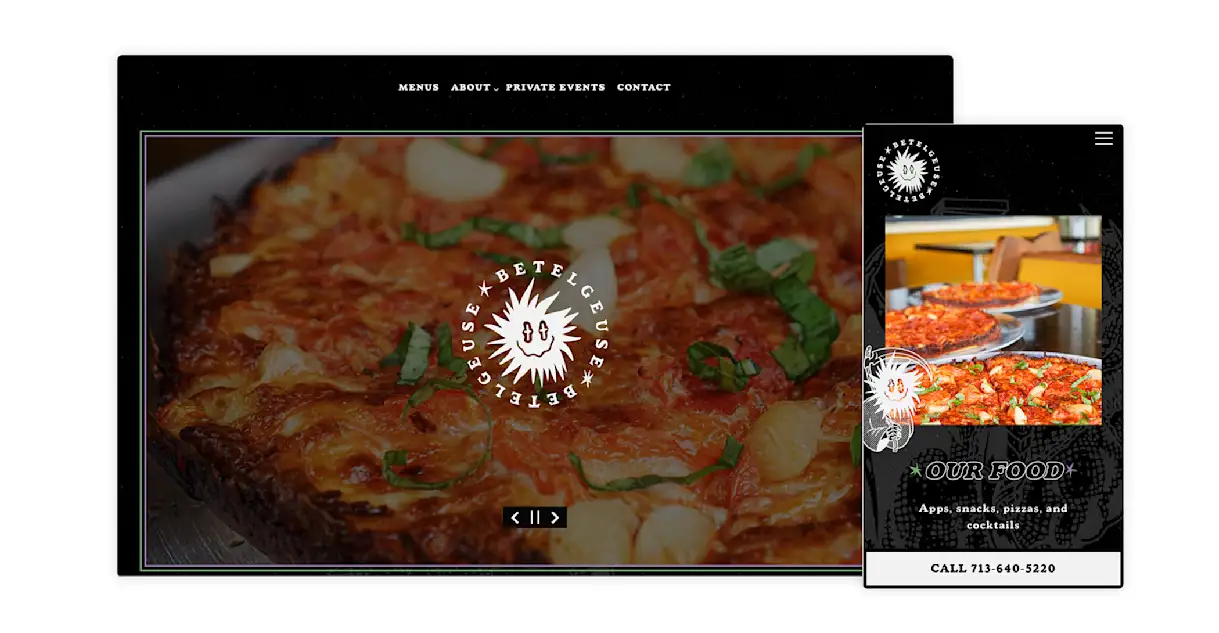
This Houston cocktail bar and pizza place pays tribute to its town’s nickname (Space City) and the local NASA Space Center. Betelgeuse is one of the brightest stars in the Orion constellation. The name is a crowd pleaser for bargoers who enjoy space culture and astronomy lovers.
Buttermilk Channel
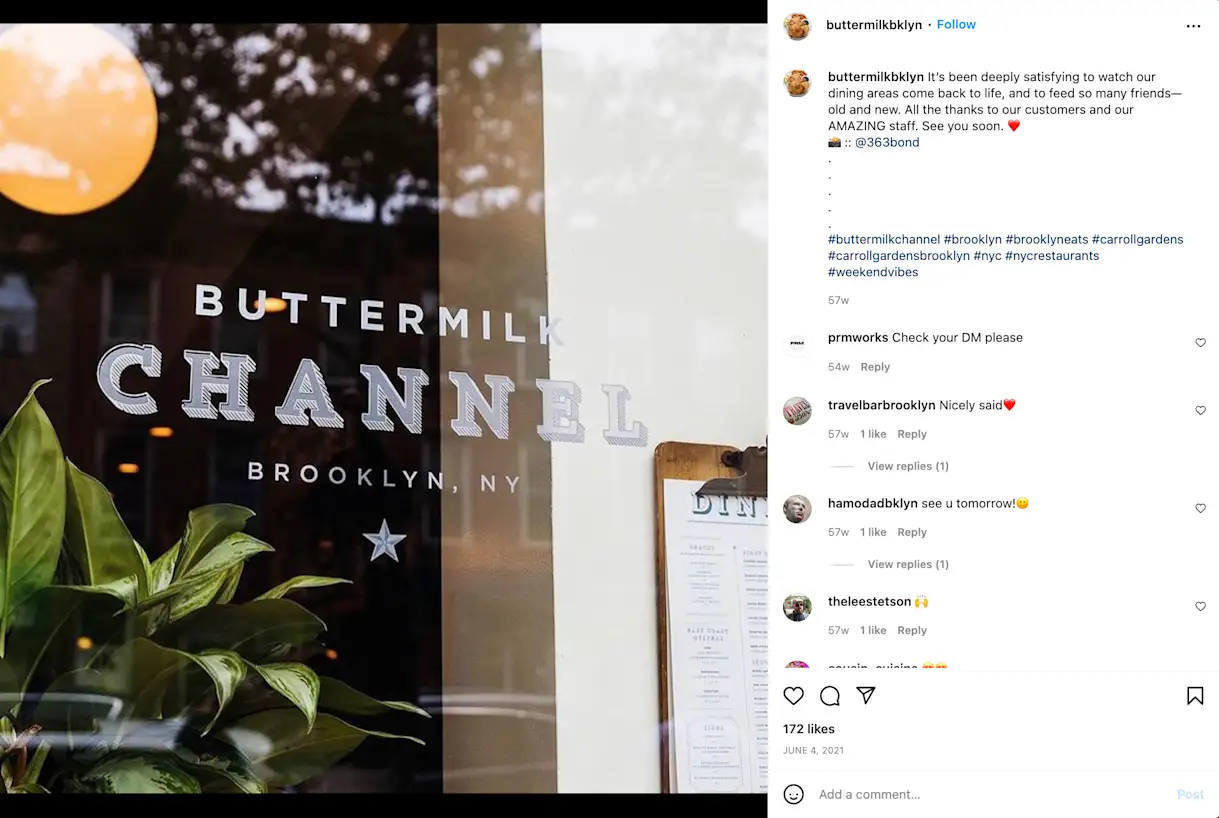
New York City geography buffs might know the aquatic inspiration behind this eatery. Between Brooklyn and Governors Island, there’s a mile-long tidal strait called Buttermilk Channel. When owner Doug Crowell opened his spot back in 2008, he named the restaurant after the nearby narrow seaway.
Shore Leave
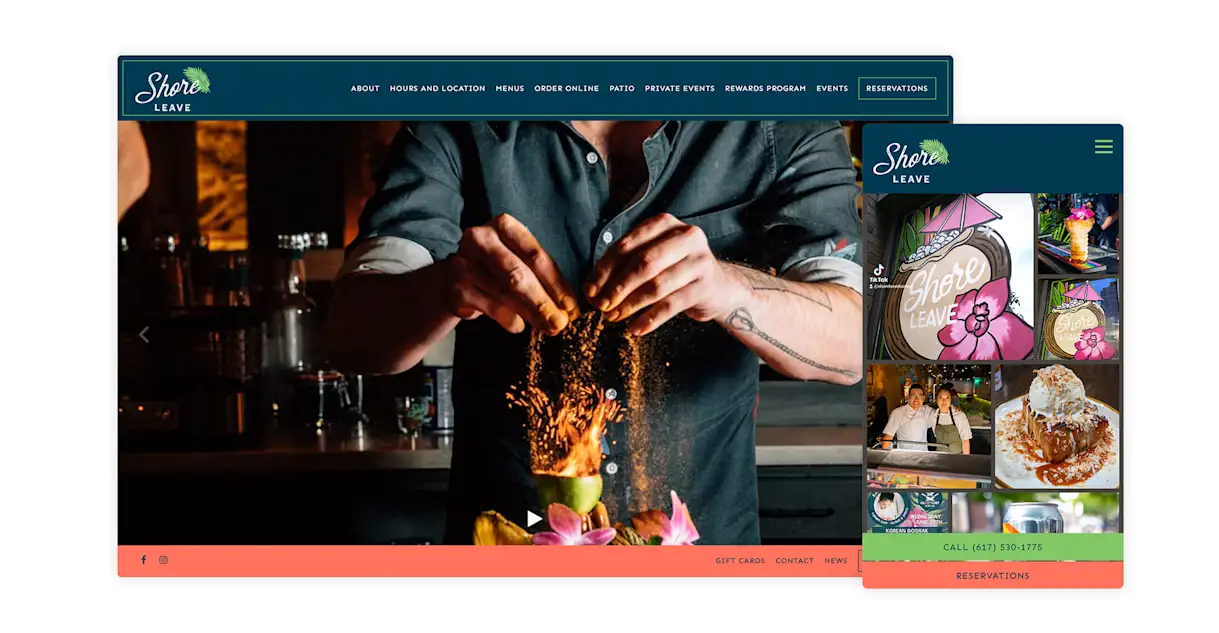
“Shore leave” is a term for the free time given to sailors on land. This oasis close to Boston Harbor has enough tropical cocktails to make anyone forget their time at sea. Shared plates, large-format sippers and island decor give Shore Leave an always-on vacation vibe.
Steel & Rye

Sitting just south of Boston, Steel & Rye’s name gives a historical nod to its neighborhood. “Steel” represents the community’s past as an industrial factory town in the 1800s while “Rye” recognizes the area’s agricultural roots that were prevalent before that. The intersection of industry and agriculture carries through the concept with a steel-framed interior and heirloom vegetables, ancient grains and locally caught seafood on the menu.
Tellers
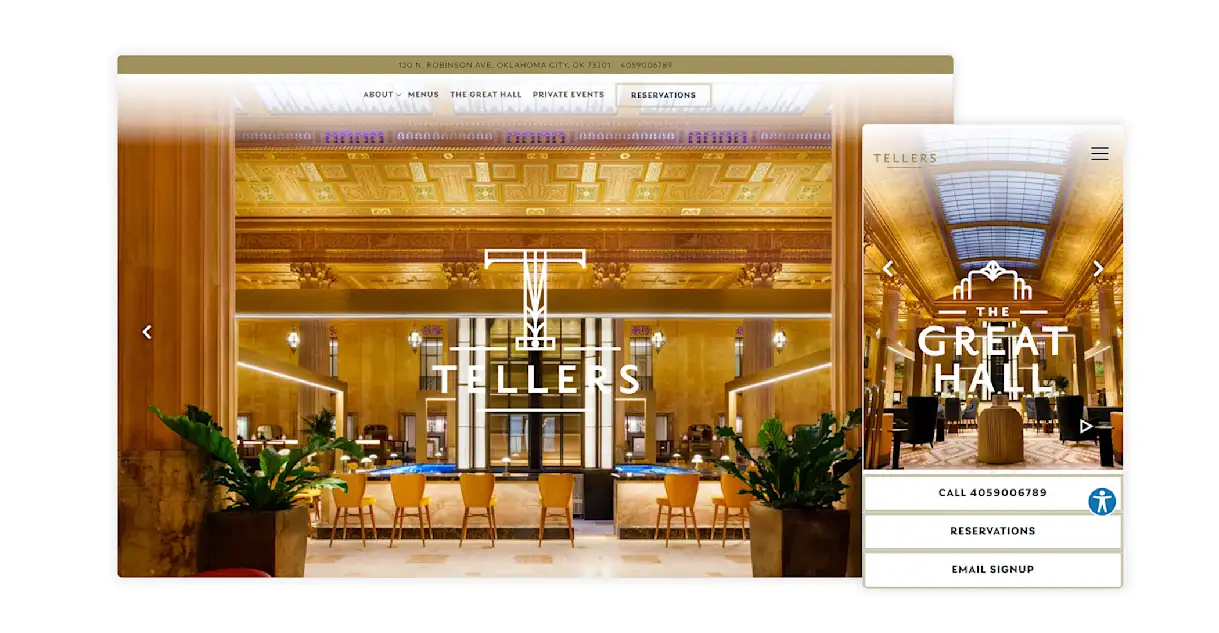
Can you think of a better name for a bank turned Italian grill? The one-word moniker is short, sweet and to the point — plus, it creatively reflects the roots of its building. Tellers is located in an Oklahoma City landmark: the historic First National Bank gallery. The original teller booths are in place and restored, giving the space a grand and communal feel.
One Twenty Three Tavern

The owners of Midtown Theatre, a historic cinema in Grand Rapids, MI, originally opened the picture house in 1944 at 123 Pearl Street. However, the space was destroyed in 1979 to make room for a parking lot. In 2019, everything came full circle when the ownership from the theater built an outdoor entertainment district complete with shops, a music venue, another cinema and restaurants, located at 123 Ionia Avenue. Fittingly, the owners named this restaurant One Twenty Three Tavern. (The best part? They tore down a parking lot to build it.)
Rowdy Tiger
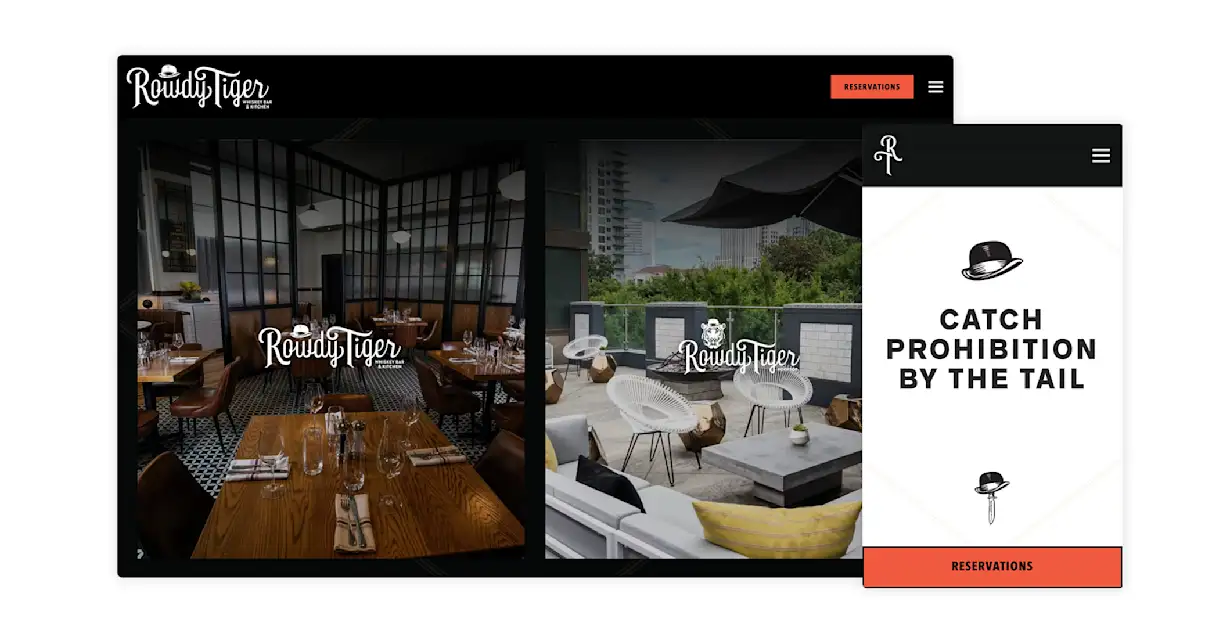
Step into a scene straight out of Prohibition at this 1920s-inspired speakeasy in Midtown Atlanta. The name is a dedication to two cultural terms that are meaningful to this neck of the woods. “Rowdy” refers to the Free and Rowdy Party, a political group popular in the 1800s that was known for making moonshine. The consumption of this liquor would typically happen in illegal bars called blind tigers. The Rowdy Tiger brand embodies the free spirit of that era and serves up modern Southern eats alongside a large collection of whiskey and whiskey-based cocktails.
Tito & Pep
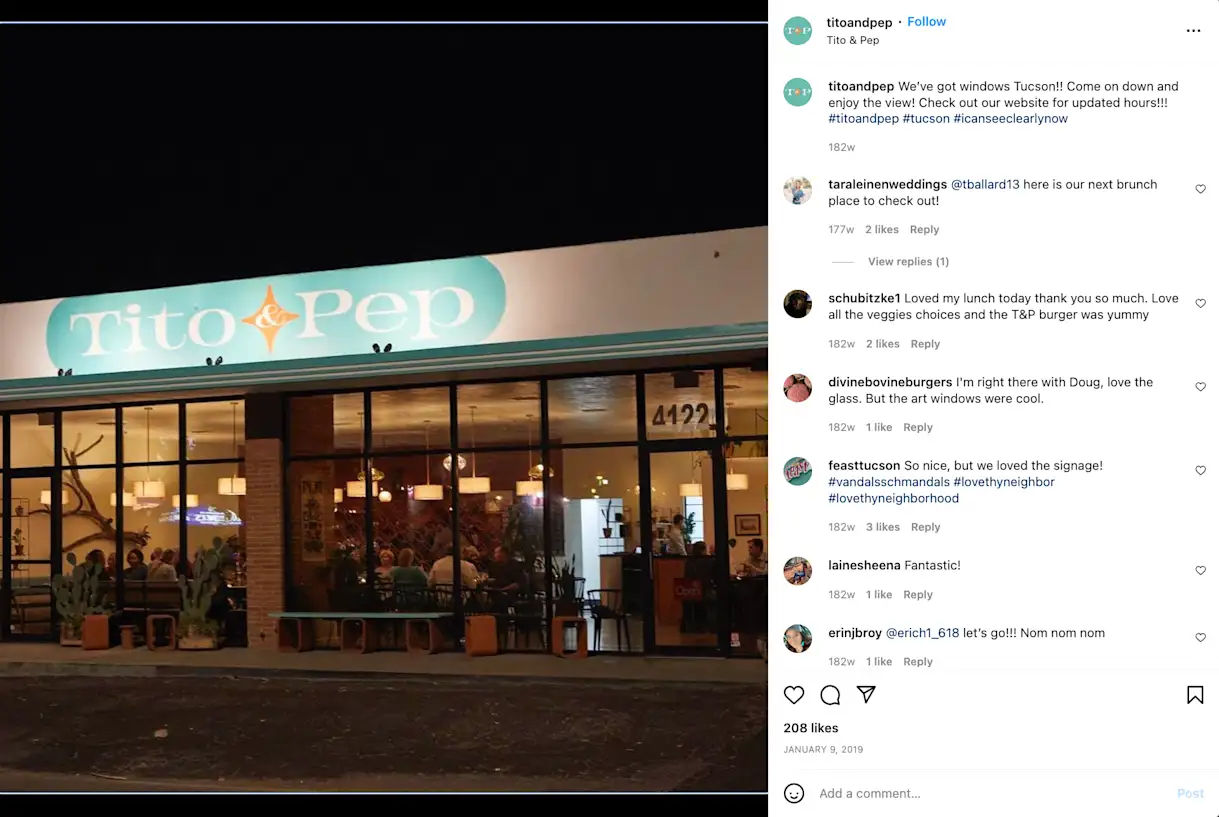
Chef-owner and 2022 James Beard Semifinalist John Martinez took inspiration for his restaurant name, Tito & Pep, from stories that his grandmother would tell to his great-aunt. Martinez’s matriarch would entertain her younger cousin with tales of two best friends who would go on adventures together: Tito and Pep. This is a slight tweak on the examples mentioned above of paying tribute to someone special in your life. In Martinez’s case, he’s saluting his grandmother’s storytelling skills.
Additional Resources for New Restaurants
Whether you’re a first-time restaurateur or a seasoned one, opening a new concept requires many important decisions. Picking a fitting restaurant name is one of the biggest choices to make since it informs so much of the concept overall. However, if you need help with other aspects such as hiring team members, marketing your opening, navigating leases, creating a business plan or designing your website, check out the resources below.
Quick Links

BentoBox Marketing & Commerce Platform
Deliver Smarter Hospitality
Want to stand out online, bring in more money, engage your diners, and streamline operations?
Recommended

New Openings
14 Types of Restaurants to Consider Opening
October 5, 2023
An overview of different restaurant concepts and what to know about them.
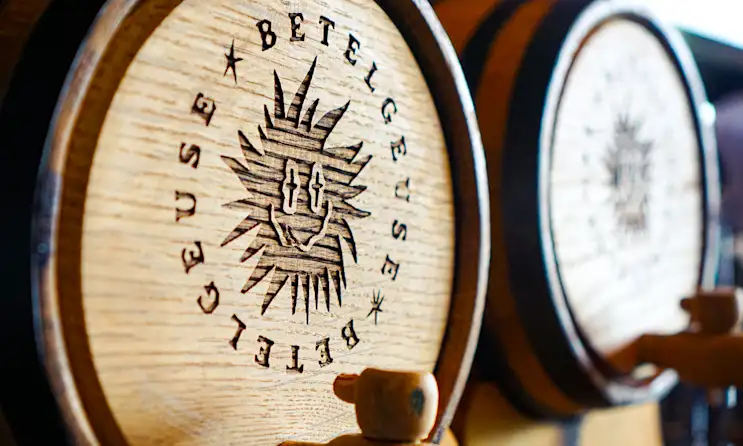
Marketing
22 Best Restaurant Logos to Inspire Your Design
January 11, 2023
Take a look at successful restaurant logo examples, and read about why they work.

New Openings
How to Get a Liquor License in California
August 2, 2022
Everything restaurants need to know about serving alcohol in the Golden State.

